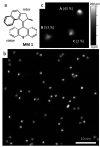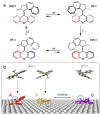Inverted Conformation Stability of a Motor Molecule on a Metal Surface
- PMID: 35686222
- PMCID: PMC9169611
- DOI: 10.1021/acs.jpcc.2c00406
Inverted Conformation Stability of a Motor Molecule on a Metal Surface
Abstract
Molecular motors have been intensely studied in solution, but less commonly on solid surfaces that offer fixed points of reference for their motion and allow high-resolution single-molecule imaging by scanning probe microscopy. Surface adsorption of molecules can also alter the potential energy surface and consequently preferred intramolecular conformations, but it is unknown how this affects motor molecules. Here, we show how the different conformations of motor molecules are modified by surface adsorption using a combination of scanning tunneling microscopy and density functional theory. These results demonstrate how the contact of a motor molecule with a solid can affect the energetics of the molecular conformations.
© 2022 The Authors. Published by American Chemical Society.
Conflict of interest statement
The authors declare no competing financial interest.
Figures





Similar articles
-
Chirality-Specific Unidirectional Rotation of Molecular Motors on Cu(111).ACS Nano. 2023 Feb 28;17(4):3958-3965. doi: 10.1021/acsnano.2c12720. Epub 2023 Feb 9. ACS Nano. 2023. PMID: 36757212 Free PMC article.
-
Development of an electrically driven molecular motor.Chem Rec. 2014 Oct;14(5):834-40. doi: 10.1002/tcr.201402007. Epub 2014 Jul 22. Chem Rec. 2014. PMID: 25048961
-
Adsorbate motors for unidirectional translation and transport.Nature. 2023 Sep;621(7977):82-86. doi: 10.1038/s41586-023-06384-y. Epub 2023 Sep 6. Nature. 2023. PMID: 37673992
-
Atomic Force Microscopy for Molecular Structure Elucidation.Angew Chem Int Ed Engl. 2018 Apr 3;57(15):3888-3908. doi: 10.1002/anie.201703509. Epub 2018 Feb 27. Angew Chem Int Ed Engl. 2018. PMID: 29485190 Review.
-
Functional and spectroscopic measurements with scanning tunneling microscopy.Annu Rev Anal Chem (Palo Alto Calif). 2008;1:857-82. doi: 10.1146/annurev.anchem.1.031207.112932. Annu Rev Anal Chem (Palo Alto Calif). 2008. PMID: 20636100 Review.
Cited by
-
Chirality-Specific Unidirectional Rotation of Molecular Motors on Cu(111).ACS Nano. 2023 Feb 28;17(4):3958-3965. doi: 10.1021/acsnano.2c12720. Epub 2023 Feb 9. ACS Nano. 2023. PMID: 36757212 Free PMC article.
-
Directing and Understanding the Translation of a Single Molecule Dipole.J Phys Chem Lett. 2023 Mar 16;14(10):2487-2492. doi: 10.1021/acs.jpclett.2c03472. Epub 2023 Mar 3. J Phys Chem Lett. 2023. PMID: 36867737 Free PMC article.
References
LinkOut - more resources
Full Text Sources
